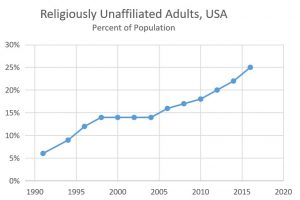
From 1971 to 1991, the religiously unaffiliated ranged between 5% and 8% of the adult population in America. While data from the General Social Survey shows that the percentage was higher in some years than others, it featured growth and decline in irregular and unpredictable ways within that narrow range.
Twenty-five years ago (1991) I had no idea what it meant to be religiously unaffiliated. Terms like “nones” or “religiously unaffiliated” were not in my vocabulary. While my young age at the time may be a contributing factor, a more significant reason is likely the relatively small role this group played in America primarily due to its size: 6%.
Since 1991, religious non-affiliation has been the fastest growing “religion” in our country. According to data from PRRI, 25% of American adults identify as having no religious affiliation in 2016. In other words, over the last two and a half decades the religiously unaffiliated grew from 1 in 16 adults to 1 in 4.
So What?
The Public Religion Research Institute (PRRI) published an article last month that everyone interested in this shift should read: “Exodus: Why Americans are Leaving Religion—and Why They’re Unlikely to Come Back.” Authors Betsy Cooper, Daniel Cox, Rachel Lienesch, and Robert P. Jones tell the story of how those without any formal religious affiliation grew to be the single largest “religious group” in America.
This article explains that the growth among the religiously unaffiliated has impacted all age cohorts. To illustrate, consider the growth by age cohort during the 20 year period of 1996 to 2016
- Young Adults (18-29): 20% to 39%
- Adults (30-49): 12% to 29%
- Middle Aged Adults (50-64): 7% to 17%
- Senior Adults (65+): 5% to 13%
Over the last twenty years all groups except young adults experienced a growth rate of of over 100% among those claiming no affiliation, while young adults experienced a growth rate of 95%. Even though young adults remain more likely than all other adults to be without religious affiliation the gap between them an older cohorts is narrowing.
- Did you realize that today 1 in 4 Americans are religious unaffiliated? If not, what is your initial response to learning this information? If so, do you find that this 1 in 4 number is also true of your closest friends and family members?
- How has the rapid rise of the religiously unaffiliated impacted your local congregation? How has it impacted your denomination, tradition, or network?
- Overall, do you think this shift is mostly positive or negative? How would you answer this question from the perspective of the well-being of our nation? from the perspective of Christianity or the Way of Jesus?
Note: For those interested in learning more, check out some of my more popular posts on this topic: